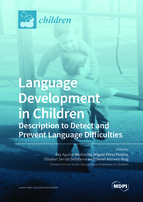Language Development in Children: Description to Detect and Prevent Language Difficulties
A special issue of Children (ISSN 2227-9067). This special issue belongs to the section "Child Neurology".
Deadline for manuscript submissions: closed (1 June 2021) | Viewed by 66959
Special Issue Editors
Interests: language development; bilingual acquisition; phonological acquisition; developmental language disorder; language assessment; bullying
Interests: language development; preterm children; blind children
Special Issues, Collections and Topics in MDPI journals
Interests: language acquisition; theory of mind; morpho-syntax acquisition; language assessment
Interests: cognitive development; bilingualism; executive control; bullying and victimization
Special Issues, Collections and Topics in MDPI journals
Special Issue Information
Dear Colleagues,
We are organizing a Special Issue entitled: “Language Development In Children: Description To Detect And Prevent Language Difficulties” for publication in the journal Children (ISSN 2227-9067; IF: 2.078). Children is an international peer-reviewed open-access journal of pediatrics published monthly online by MDPI. The publication focuses on sharing clinical, epidemiological, and translational science relevant to children’s health. For detailed information on the journal, we refer you to https://www.mdpi.com/journal/children.
The present Special Issue aims to publish studies on language acquisition in children. We are especially focused on the description of language development and the variables affecting the early detection and prevention of language difficulties. Although language difficulties are very common (14% of children present a primary or secondary language difficulty), these difficulties are misdiagnosed due to the lack of visibility and updated knowledge from professionals of their long-term consequences in education and mental health. To prevent the misdiagnosed identification and assessment of language difficulties, more typical and atypical language studies are needed. In this sense, a good description of language acquisition could help to detect and prevent language difficulties. Nevertheless, most of the research on child language development has been conducted in English. However, studies in other languages and cross-linguistic studies have shown that some results about language development in English may not be transferred into other languages. Despite the increase in the number of studies, there is still little research about typical and atypical language acquisition in other languages and in bilingual populations. Therefore, this Special Issue aims to fill the current void in these studies, give them visibility, and show the latest research about language acquisition in children.This Special Issue is open to any research addressing a perspective of child language from a psycholinguistic, psychological, linguistic and/or educational point of view, including theoretical and empirical studies on typical and atypical child language acquisition and their association with other variables (either social or genetic) that could affect them.
Dr. Eva Aguilar-Mediavilla
Dr. Miguel Pérez-Pereira
Dr. Elisabet Serrat-Sellabona
Dr. Daniel Adrover-Roig
Guest Editors
Manuscript Submission Information
Manuscripts should be submitted online at www.mdpi.com by registering and logging in to this website. Once you are registered, click here to go to the submission form. Manuscripts can be submitted until the deadline. All submissions that pass pre-check are peer-reviewed. Accepted papers will be published continuously in the journal (as soon as accepted) and will be listed together on the special issue website. Research articles, review articles as well as short communications are invited. For planned papers, a title and short abstract (about 100 words) can be sent to the Editorial Office for announcement on this website.
Submitted manuscripts should not have been published previously, nor be under consideration for publication elsewhere (except conference proceedings papers). All manuscripts are thoroughly refereed through a single-blind peer-review process. A guide for authors and other relevant information for submission of manuscripts is available on the Instructions for Authors page. Children is an international peer-reviewed open access monthly journal published by MDPI.
Please visit the Instructions for Authors page before submitting a manuscript. The Article Processing Charge (APC) for publication in this open access journal is 2400 CHF (Swiss Francs). Submitted papers should be well formatted and use good English. Authors may use MDPI's English editing service prior to publication or during author revisions.
Keywords
- language acquisition
- atypical language acquisition
- detection
- assessment
- language difficulties
- primary prevention










